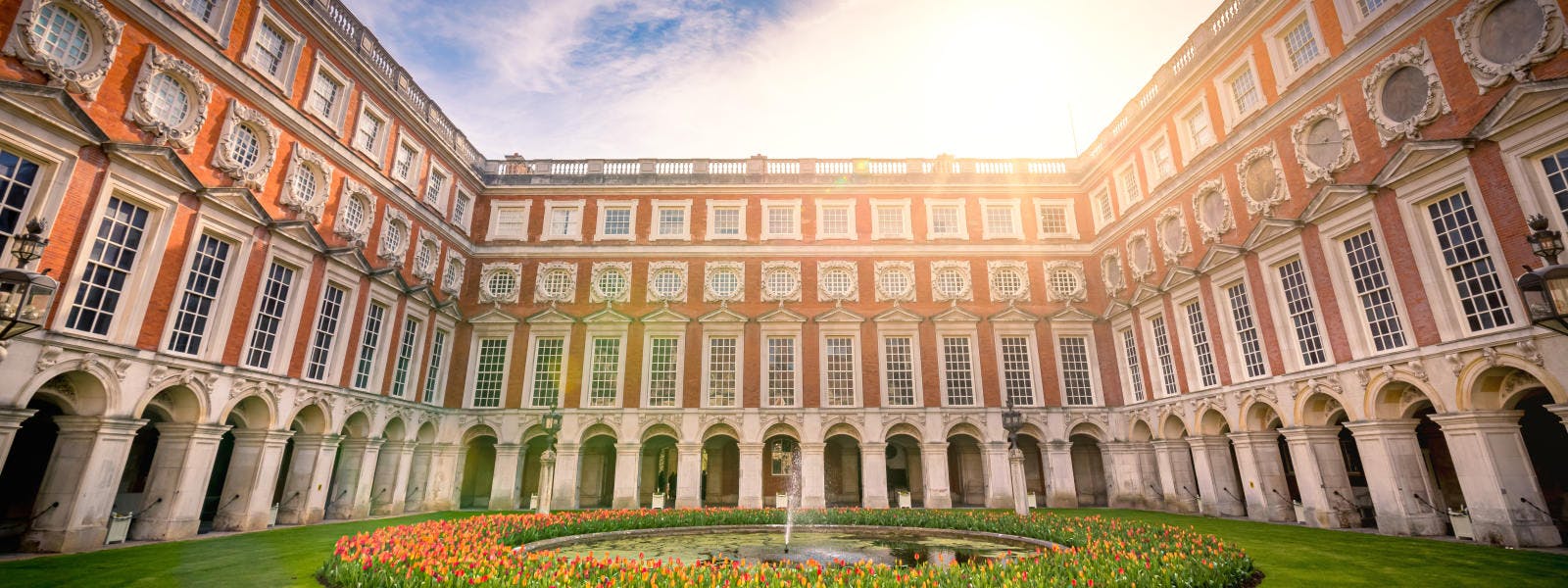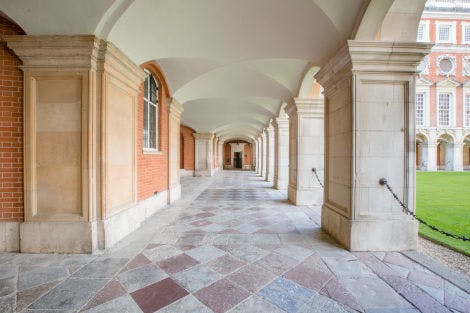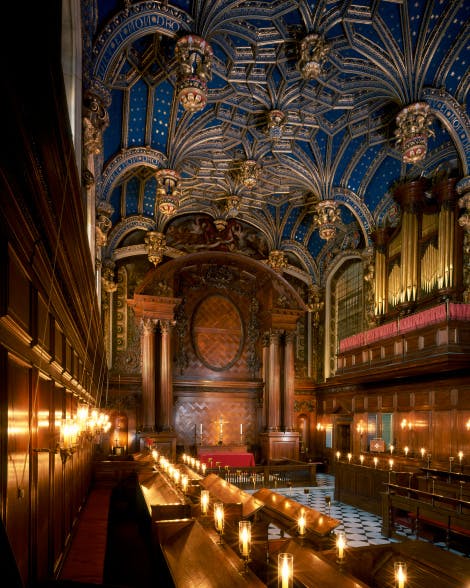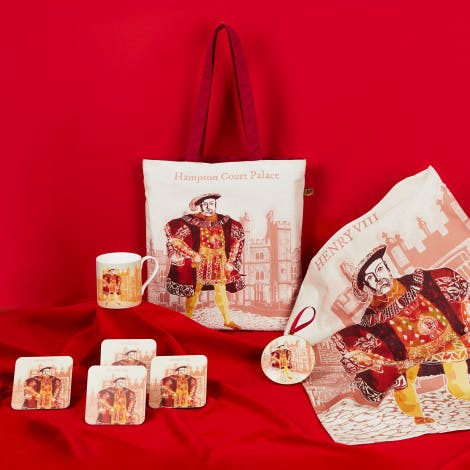
Skip the event ticket details and go to event summary.
When
Open In line with palace hoursTicketing information
Included in palace admission (Members go free)
Buy Hampton Court Palace ticketsThe heart of the Baroque palace
Fountain Court forms an important part of Christopher Wren’s baroque remodelling of the palace for William III and Mary II (1689-1702) which he began designing in 1689.
Fountain Court held private and state apartments for both the King and Queen, the Lower Orangery, and the grand colonnade in Clock Court, providing a grand entrance to the King's Apartments.
Much more recently, this stunning court has featured as a filming location for Bridgerton, the hit regency drama on Netflix.
The history of Fountain Court
The Fountain Court we see today was preceded by Green Cloister Court dating from the reign of Henry VIII. This had itself once been an earlier Tudor Knot Garden: a formal garden of herbs and shrubs laid out in intricate patterns.
Work on Fountain Court began in 1689 when the Tudor private apartments were demolished and foundations were dug. The construction process was initially very fast-paced, but after a deadly collapse took the lives of two workers in early December 1689 it slowed considerably.
The new construction was still ongoing in 1694 when another tragedy brought a near-complete halt to the works, the death of Mary II. On Mary’s death, most work on the palace was halted. It was not until 1699 that William III decided to restart the construction works.
The new palace included lots of room for members of William III’s court. The most important courtiers were given the most space. The King’s favourite, Lord Albermarle, was assigned eight rooms and four closets directly adjacent to the King’s private apartments, and a further seven rooms on an upper floor.
Other members of the court had to make do with much smaller apartments, often in the older Tudor parts of the palace.

Image: Fountain Court, an important part of the Baroque palace. © Historic Royal Palaces
Working at the palace
Fountain Court also accommodated many of the people who were essential to keep the palace functioning. Accommodation was provided for numerous secretaries, pages and the necessary women. These servants, including Mr Kemps the chocolate maker and Mr Vermain the barber, ensured the smooth running of the palace and it was important to keep them close to the King.
Rooms around Fountain Court were also given over to other functions. The ground floor included store rooms, confectionaries and a chocolate kitchen.
End of an era
In 1737, the royal family ceased using Hampton Court as a royal residence. Many of the apartments were given to new grace-and-favour residents and a new palace community started to develop.
Restoration
In 1986, there was a terrible fire at Hampton Court Palace which started in the south range of Fountain Court. Refurbishments of these apartments continued into the 1990s.
Now restored to its former grandeur, Fountain Court is open for visitors to explore its elegant baroque architecture.

Image: © Historic Royal Palaces
Explore what's on

- Things to see
Georgian Story
Discover the grandeur of the Georgian royal court and follow in the footsteps of queens and kings in the rooms where they lived and entertained guests.
-
Open
- Hampton Court Palace
- Included in palace admission (Members go free)

- Things to see
Hampton Court Gardens
Take time to explore and relax in these world-renowned gardens and find our free entry Garden Open Days dates.
- Open
- In line with palace opening hours
- Hampton Court Palace
- Included in palace admission (Members go free)

- Things to see
William III's apartments
Enjoy the beautiful State Apartments and private rooms of William III at Hampton Court Palace as part of your visit.
-
Open
- In line with palace opening hours
- Hampton Court Palace
- Included in palace admission (Members go free)
Browse more history and stories

Chocolate fit for a king
Where royal chocolate makers prepared this expensive delicacy

The gardens at Hampton Court Palace
A brief history of the famous royal gardens

The story of Hampton Court Palace
Home of Henry VIII and the Tudor dynasty
Shop online

Shop Hampton Court Palace
Explore our gifts and souvenirs, inspired by over 500 years of history from Hampton Court Palace.
From £2.50

Shop Tudors
Find the perfect gift for collectors and history enthusiasts in our treasure trove of souvenirs inspired by this ever-fascinating dynasty.
From £3.00

Shop Jewellery
Discover our timeless jewellery collection, each piece inspired by the beauty and history of the palaces in our care.
From £2.50
